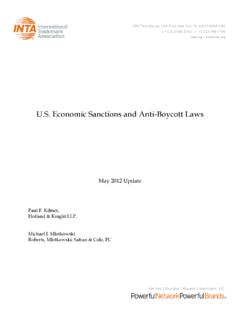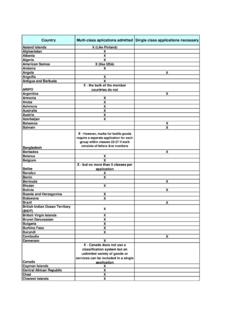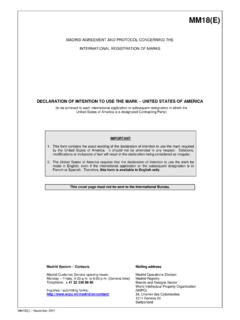Transcription of Opposition and Cancellation Standards and …
1 1 Opposition and Cancellation Standards and Procedures Subcommittee INTA Enforcement Committee Report and Recommendations: Partial Cancellation Actions Based on Non-Use June 2011 2 I. Introduction The Opposition and Cancellation Standards and Procedures Subcommittee was charged with analyzing non-use Cancellation actions in selected jurisdictions where the mark is used on some but not all of the goods and services covered in the registration and determining whether harmonization or standardization is possible or should be encouraged. This report summarizes and analyzes the Subcommittee s findings on this issue and sets forth its conclusion that INTA should encourage and promote the availability of mechanisms for third parties to remove goods and services from the scope of existing trademark registrations when the registration owner has not used the mark with those goods or services.
2 For the purposes of this report, partial non-use Cancellation means removing certain goods or services from the scope of protection of a trademark registration where a third-party establishes that the owner of the registration has not used the mark with those goods or services, while maintaining protection for those goods and services with which the trademark has been used. In other words, partial non-use Cancellation means a reduction or limitation of the list of products or services comprised in the registration, eliminating those in respect to which the mark has not been used.
3 In performing the task, this subcommittee took into consideration the reports of previous INTA committees and subcommittees, as follows: Use-based Trademark Rights Task Force ( 2003 Report ), which conducted a survey in which INTA members were asked to identify the advantages and disadvantages of three types of systems with varied use requirements; Use-Related Requirements For Issuance And Maintenance Of Trade Mark Registrations ( 2005 Report ), which analyzed advantages and disadvantages of use-based trade mark registration systems in light of INTA s goal to promote harmonization of trade mark law and practice.
4 Part Cancellation Report of Europe & Central Asia Subcommittee of the Legislation and Regulation Committee ( 2009 Report ), which compared the various approaches of the competent trademark offices or courts with respect to the requirement to provide evidence for genuine use in trademark proceedings. The Subcommittee also considered existing INTA policy statements regarding use requirements as described, in particular, in INTA's Model Law Guidelines (last revised Nov. 2007) (see the discussion in Section III of this report). These documents are available from the INTA web site and are attached as Appendix A to this report.
5 The Subcommittee members who contributed to this report include Orlando Cardoza, Todd Deveau, Peter Eriksson, Tanya Indra Escamilla Lujan, Wiebke Gorny, Pavel Gorokhov, Katherine Keating, Hung Nguyen, Anita Polott, Dafne Ramos Samanez, Pamela Rask, Christopher Schneider, Ana Vargas, Romain Viret and Michael Zuck. II. Initial Research As a starting point, the Subcommittee surveyed attorneys from 71 countries1 to determine specific differences among non-use Cancellation proceedings, harmonization or standardization of which may be desirable. We asked representatives from each country/region to provide us with some general comments about non-use Cancellation procedures in their countries.
6 To enable us to more fully understand and compare non-use Cancellation proceedings we also researched the INTA on- 1 For the purposes of this survey, Belgium, The Netherlands and Luxembourg are considered as three separate countries. 3 line Country Guides and Opposition Guide. Our main findings are summarized below and are set forth in detail in the chart attached as Appendix B to this report: Are non-use Cancellation actions available in your country? Almost all the surveyed jurisdictions allow non-use Cancellation actions.
7 The only jurisdictions identified as not allowing non-use cancellations are Chile, Monaco and Uruguay. What are the legal requirements? Most of the countries (45) allow challenging trademark registration on non-use grounds where the trademark has not been used for five successive years. These countries are: Argentina, Austria, Bahrain, Belarus, Belgium, Bosnia and Herzegovina, Costa Rica, Croatia, Cyprus, the Czech Republic, Denmark, Egypt, El Salvador, Estonia, the European Union, Finland, France, Germany, Greece, Hungary, Ireland, Italy, Kenya, Latvia, Lithuania, Luxembourg, Malta, Montenegro, Morocco, the Netherlands, Poland, Portugal, Moldova, Romania, Senegal, Serbia, Slovakia, Slovenia, South Africa, Spain, Sri Lanka, Switzerland, Turkey, the United Kingdom and Uzbekistan.
8 As is evident, a five-year non-use grace period exists in practically all European countries. Some jurisdictions (22) provide for a shorter non-use grace period - of three successive years. Those countries are: Canada, China, Colombia, Cuba, the Dominican Republic, Ecuador, Honduras, Indonesia, Israel, Japan, Kazakhstan, Kyrgyzstan, Mexico, Nicaragua, Oman, Peru, Korea, Russia, Taiwan, Trinidad & Tobago, Ukraine and the What is the Authority in charge of the procedure? In 27 countries non-use Cancellation actions are reviewed by the courts.
9 In 32 countries they are reviewed by the Registrar, national PTO, or similar administrative authorities. Nine countries provide for both legal and administrative procedures. What evidence is required from a claimant? In 30 countries it is required that a claimant prove lack of use of a trademark. This number includes those countries where it has become customary in practice to file such evidence even though the claimant is not formally required to supply it. In 19 countries the claimant is required to prove a legitimate interest in the Cancellation of a trademark.
10 This number includes those countries whose survey respondents did not specifically mention such requirement, but where the law requires the claimant to be an interested person. Hence, we assume that the claimant in these countries is likely to be required to prove its legal interest. The interest may be an activity linked to the products or services covered by the trademark (like in France), or the claimant may suffer from the respective registration ( , the Trademark Office cites the other mark as an obstacle against the claimant s application), as in Finland.











